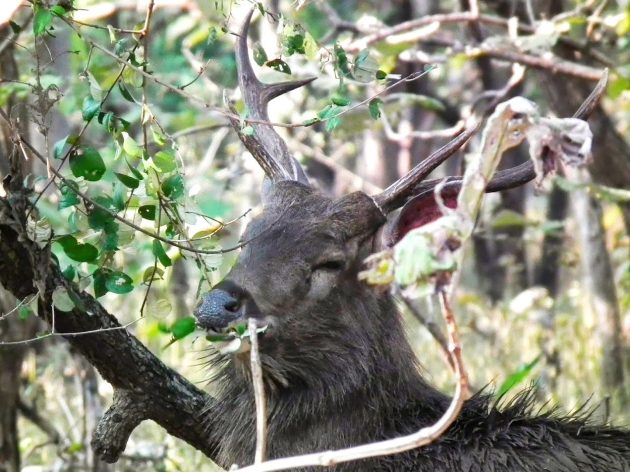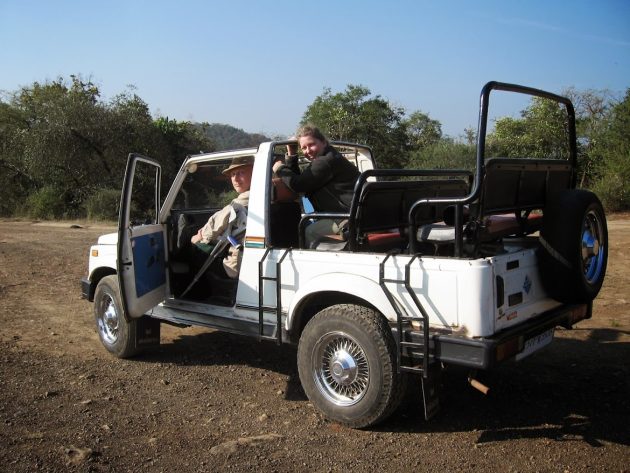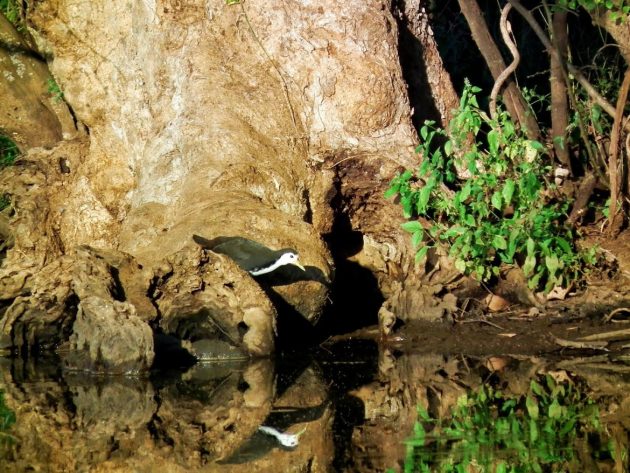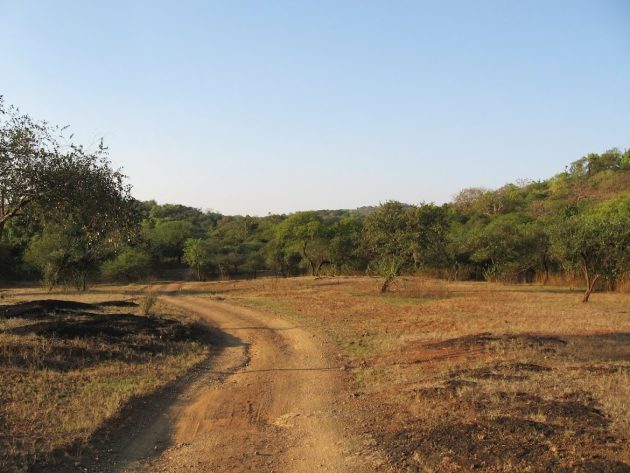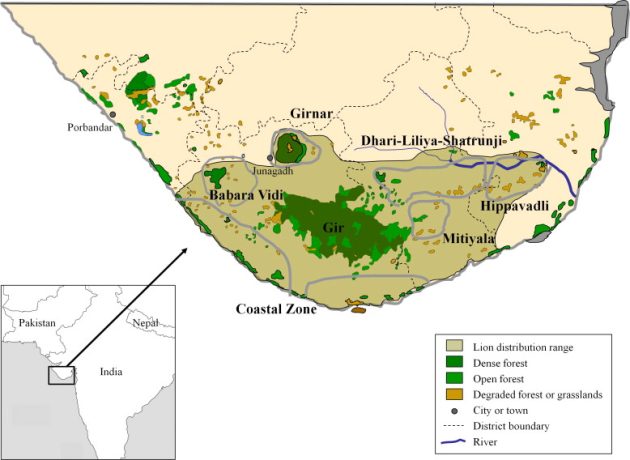After a number of sport drives, as soon as once more we’re on the entrance gate of the Gir Nationwide Park within the state of Gujarat. This park protects the most important remaining tract of dry deciduous forest within the west of India, providing guests 37 species of reptiles, 38 species of mammals and, to not be forgotten – virtually 300 fowl species.
Nonetheless, for almost all of tourists, there appear to be just one species – a number of the final of the 670 remaining Asiatic Lions (Panthera leo persica). Due to this fact, it’s fairly annoying to listen to a standard query from a passing Maruti Gypsy: “Have you ever seen the lions?” “Sure, we did – so what? We’re right here for the birds!”
Lions apart, carnivores are represented by Leopard, Striped Hyena, Jackal, and many others., whereas herbivores are represented by Chital and Sambar (above) deer, Wild Boar, Nilgai antelope, and many others. The most important reptile is the Indian Mugger Crocodile.
As a consequence, many of the guides know solely mammals, and even those that declare to know birds will have the ability to present you solely the most common species, these that you’ve got discovered to ID in your Indian day one. Understandably, we have been reserved when, as soon as once more, we have been instructed that we’ll be accompanied by Manoj (learn “j” like “ch”), an professional on birds who declare to be able to displaying us some extra nocturnal creatures…
A flock of Crested Treeswifts is circling above us. Judging by the map within the area information, they aren’t speculated to be right here in any respect. But, they’ve – wings!
An open Gypsy follows dust tracks by dry deciduous forest dominated with teak. Gir contains various habitats, from open scrubland to each dry deciduous and tropical thorn forest and evergreen corridors alongside the rivers. Disinterested Grey Langurs await us within the subsequent tree crown; one Black-rumped Flameback woodpecker is looking the branches, whereas one beautiful Tickell’s Blue Flycatcher flies by. On the low acacia by the street, a Shikra retains a watchful eye on us. The most typical giant mammals of the park are smallish, noticed forest deer – Chitals, and we frequently encounter small herds. A number of Indian Peafowl are looking dry leaves by the roadside. Getting used to peacocks as ornamental backyard birds, I discover it arduous to acknowledge them as genuine wild birds.
We’re crossing the ridge and coming into the valley of one of many seven rivers of the park. Within the dry season, floor water turns into arduous to search out and the park officers have created 4 bigger dams, but additionally quite a few small ones wherever the street crosses the river. On the financial institution of 1 such small dam, a Softshell Turtle basks within the afternoon solar, whereas one Oriental Magpie-Robin is looking the water edge. A low department is adorned by a Inexperienced Bee-eater and a tree high above it holds a number of Cattle Egrets. There’s a Purple-wattled Lapwing on a mud bar, whereas behind a dry bush… some fowl is taking part in conceal and search with us… a beautiful White-breasted Waterhen (under). After a optimistic ID, it flies to the protruded roots of a giant tree, displaying itself effectively within the tender daylight.
A bit bit additional, whereas watching a big Sambar wallowing within the mudbath, Manoj factors our consideration to a Crested Honey Buzzard on one and a Changeable Hawk-Eagle on one other tree. Possibly his popularity will not be with no basis?
Wild Boar stands subsequent to the street, watching us with out nervousness or concern. It belongs to the identical species as these in Europe, however a smaller subspecies (Sus scrofa davidi). Beneath an arched department, one acquainted fowl, a Widespread Blackbird feminine… however after a current cut up in 2005 by Rasmussen and Anderton, it was elevated to a full species – Indian Blackbird (Turdus simillimus).
Three Indian Jackals are strolling by a sundown. Visiting occasions are restricted to 2 and a half hours within the morning and night, and a safari driver who overstays these occasions could also be fined, so our driver will increase the velocity. Chitals are crossing the street, however we have now seen too lots of them to cease now. Often we go so rapidly that we could also be posing a hazard for jay-walking animals…
…after which, for no apparent cause, we all of a sudden cease! We have now virtually forgotten that Manoj has promised us some creatures of the night time, when he raised his hand to level at three Mottled Wooden Owls proper above us (cowl picture), lovely giant Strix owls barely amused by us. There may be barely sufficient mild for a photograph.
And when our driver continues, we have now a brand new respect for our information and really feel sorry that we had no probability to e-book his providers for earlier drives. The one true fowl information among the many quite a few park guides, he was busy displaying – mammals to the vacationers (we’re actually not vacationers – we’re birders!).
After a brief drive, we cease once more and Manoj leads our eyes up a tree trunk, than a facet department and… to the Indian Nightjar mendacity low alongside the department and melting into it with its camouflage plumage.
A longish drive – lengthy sufficient to overlook that he has really promised us two owls. But, we cease once more and Manoj factors our consideration to a gap half-way up a tree trunk: there’s an Indian Scops Owl in it. Manoj actually is aware of his owls.
There isn’t any extra cause to cease, se we go all the way in which, roller-coaster fashion, actual hazard for naive deer that show sensible sufficient to keep away from us. Two owls and a nightjar! Gir is a incredible birding space! Within the phrases of Indian ornithologist Salim Ali, had Gir not been the Lion sanctuary, it might have been termed one of many best fowl sanctuaries in Gujarat!
We gave Manoj twice the same old and well-earned tip, promising to advocate him to different birders. Promise fulfilled.
Photographs © Dusanka Stokovic Simic & Dragan Simic
Source link

